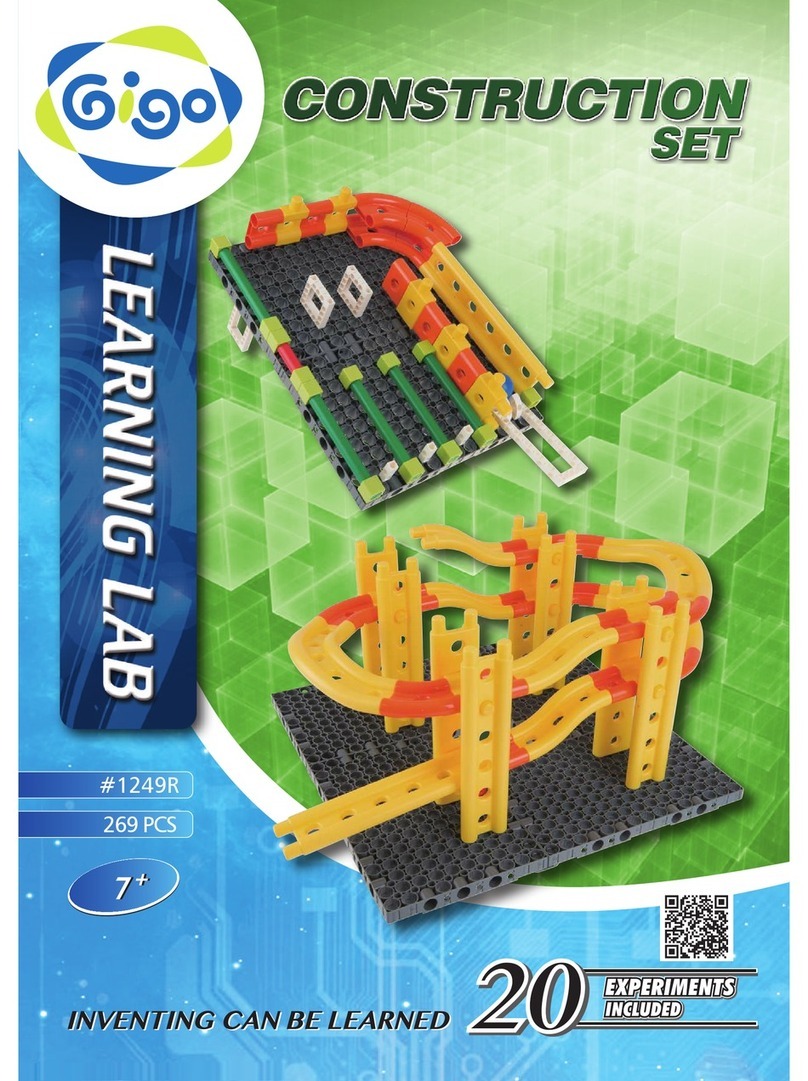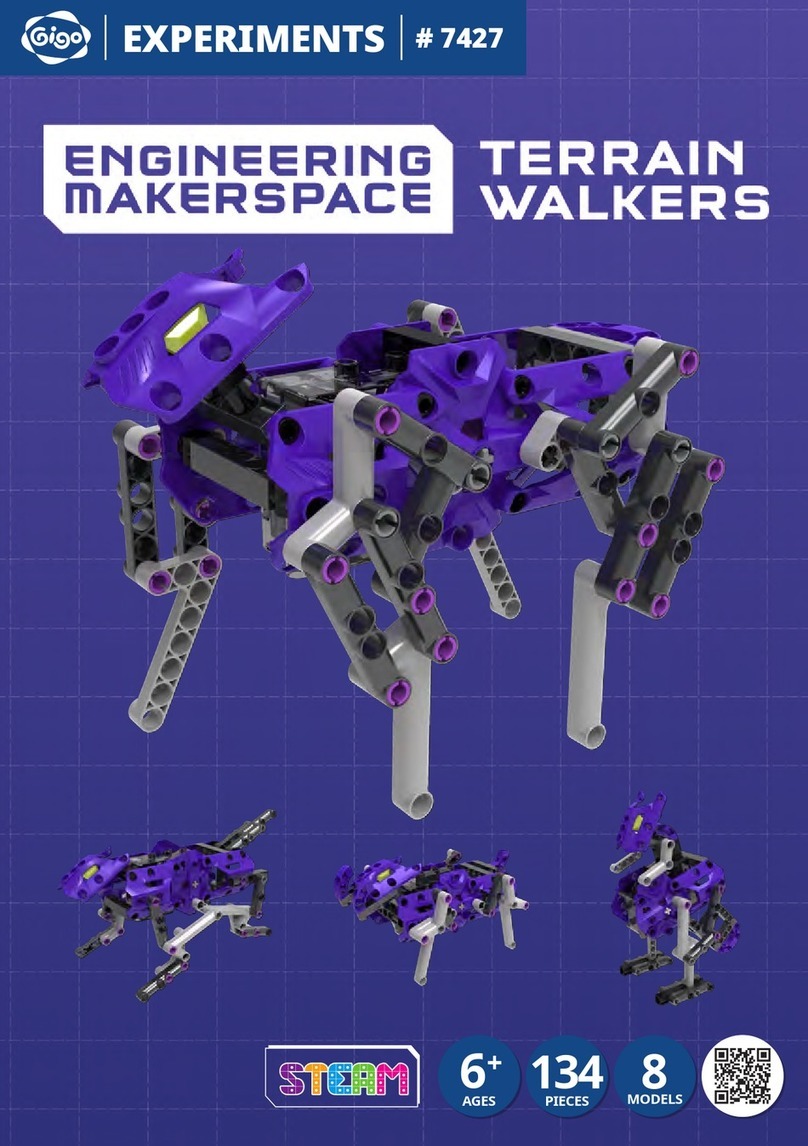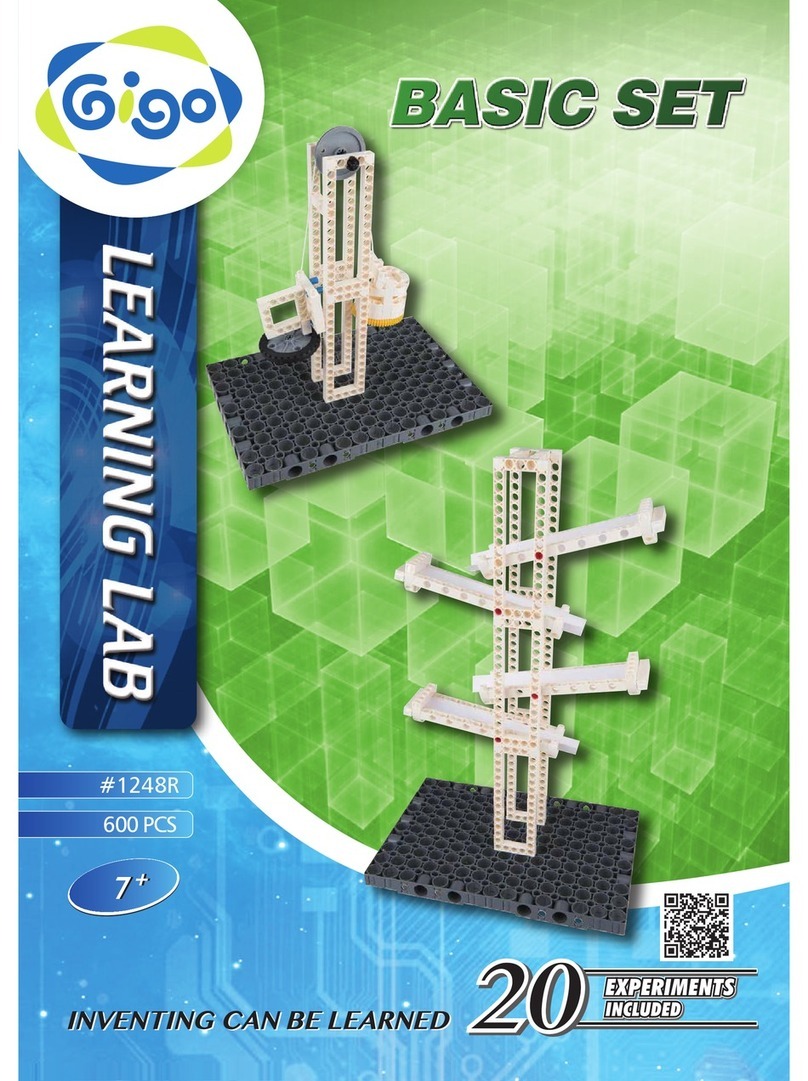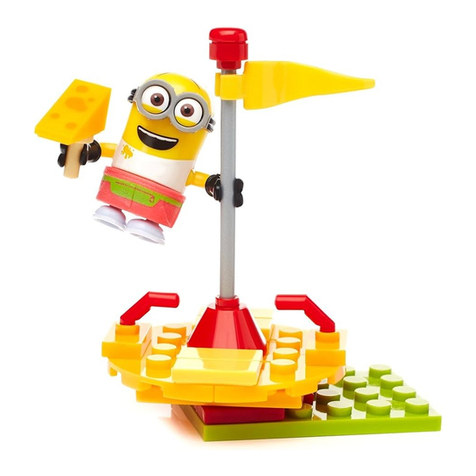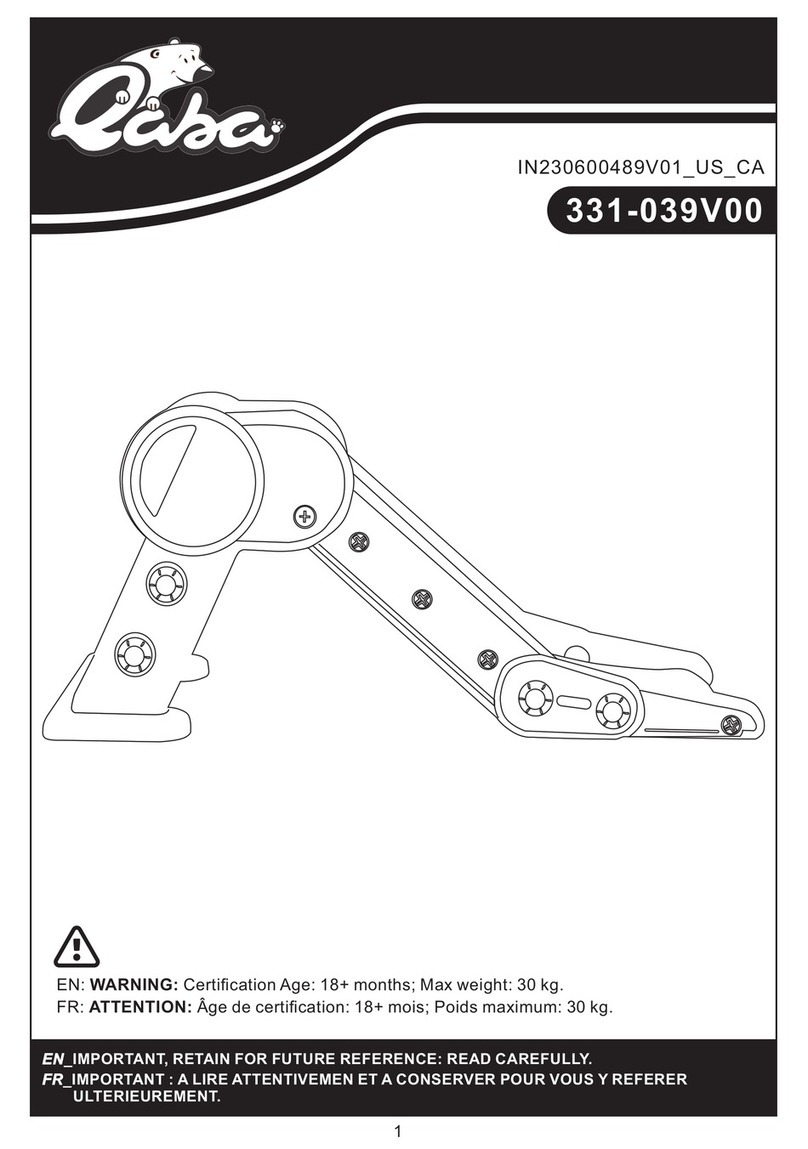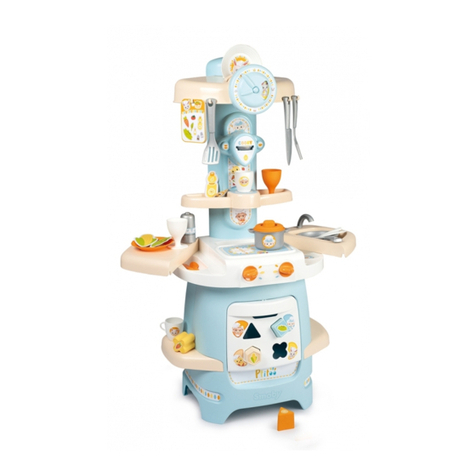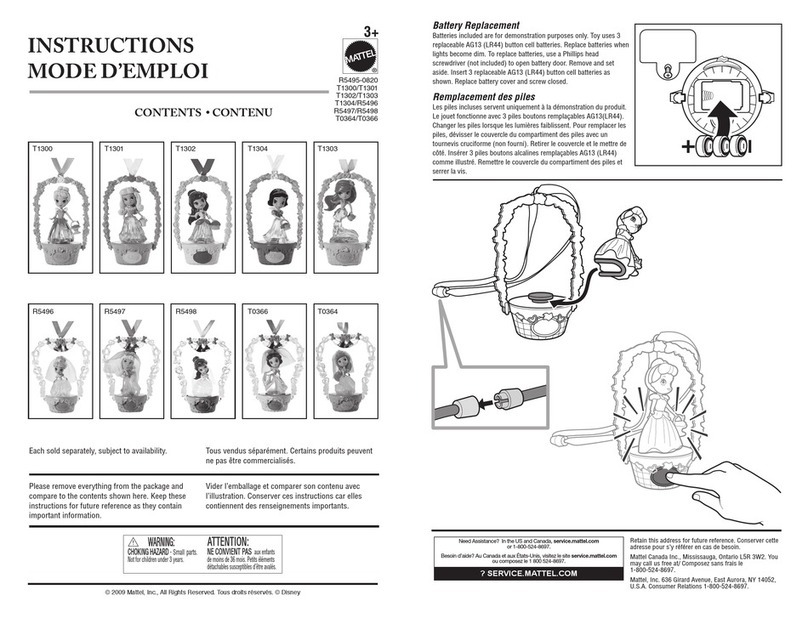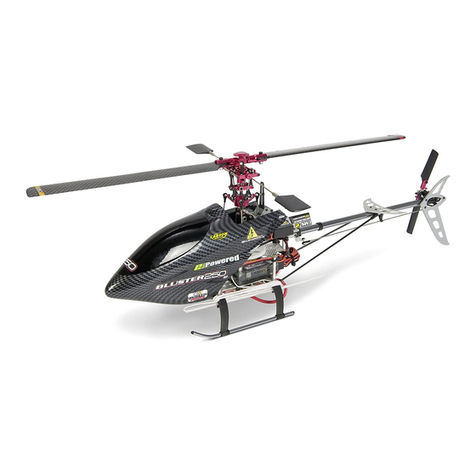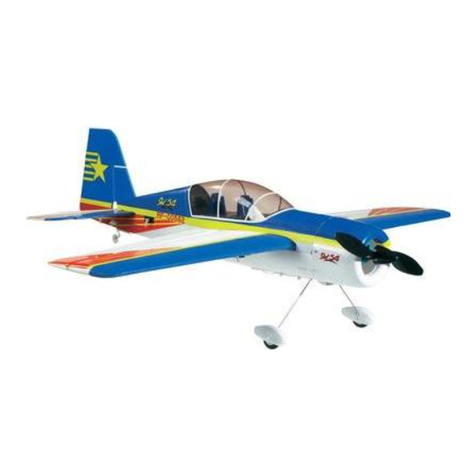Gigo ROBOTICS GECKOBOT 7409 User manual

# 7409
ROBOTICS
176
PIECES
8+
AGES
7
MODELS

1
Table of Contents............................................................................................. 1
Kit Contents....................................................................................................... 2
Safety Information .......................................................................................... 3
MODELS
Geckobot .................................................................................................................. 4
How to operate the geckobot............................................................................15
Industrial robot arm .......................................................................................... 17
Suction tow truck ............................................................................................... 19
Suction gun ........................................................................................................... 21
Inch worm ............................................................................................................. 23
Smartphone holder ............................................................................................ 24
Ellipsograph ......................................................................................................... 25
TIP!
At the top of each model assembly page, you will find a red bar:
›››
It shows how difficult the model’s assembly will be:
easy medium hard
HOW DO SUCTION CUPS WORK
Suction cups are devices that use air pressure or
water pressure to stick to hard, smooth surfaces
where a partial vacuum can be created.
A suction cup has a cup-shaped surface made
of a flexible material, like silicone, rubber, or
plastic. When this cup is pressed against a hard
surface, the air inside the cup, between the cup
and the surface, gets pushed out. Air particles
get pushed out, creating a void, or vacuum,
inside the cup. The regular atmospheric air
outside the cup remains the same, containing
many more air particles per unit volume of
space than inside the cup. All these air particles
are constantly flying around through the air and
hiing things. Each one makes a tiny impact.
The sum of all these tiny impacts is air pressure.
There are a lot more air particles per
unit volume on the outside of the cup
than on the inside, so the air pressure is
a lot higher on the outside than on the
inside. This difference in air pressure is
what keeps the suction cup stuck to the
surface.
Over time, the material of the suction
cup returns to its original shape. The
forces pulling the suction cup back into
its original shape are ultimately
stronger than the air pressure keeping
the suction cup stuck to the surface.
When the suction cup returns to its
original shape, the low pressure inside
the cup is released, so the suction cup
will no longer stick to the surface.
TIP! The peg remover
In the box, you will find a little yellow tool called the peg remover.
1. End A of the peg remover makes it easy to remove pegs from the frames.
2. End B of the tool can be used for prying up and separating other parts. 1 2
A
B
Suction cup Air particles
Surface
Unstuck suction cup:
Pressing suction cup down:
Stuck suction cup:
Low pressure
› › › TABLE OF CONTENTS

2
No. Description Qty. Item No.
B-short peg WCY
C-long peg WCO
C-axle connector WAR
C-tube bolt WGO
C-tube bolt cap WFO
C-axle WHY
C-cam connector WJR
C-two-in-one converter WGTB
C-long button fixer WETY
C-odxmm tube WGD
C- hole round rod WCG
C-bended rod WVG
C-bended rod WVG
C- hole dual rod WSG
C- hole rod WKG
C- hole prolate rod WCG
C- hole prolate rod WCG
C- hole round rod WCG
C- hole rod WCG
C-x frame WTG
C-mm axle II WOD
No. Description Qty. Item No.
C-mm axle II WMD
C-mm axle II WQD
C-t gear WDS
C-triangle connector WBG
C-buoy fixing WKG
C-mm tube A W
B-peg remover WBY
C-cap with hole WFR
C- hole crank WHG
C- hole crank WHG
C-pear cam WGR
C-drop cam WGR
C- hole ° connector WIG
C-suction pad WE
C-pneumatic valve with two outputs WDG
C-pneumatic valve with two outputs WDG
C-pneumatic pump WCG
C-pneumatic pump WCG
C- way motor WA
Geckobot eye stickers R#
9 cm x 2 15 cm x 2 17 cm x 2 20 cm x 3 27 cm x 2
NOTE! Cutting the tube to length
You must cut the 200-cm tube into these lengths. The specific lengths needed for each
model are indicated in the assembly instructions for each model. You will have 4 cm of
tube left over after cutting. You can use the measuring guide on the right edge of this page.
You can also write the lengths on the tubes with a pen so they are easier to tell apart.
You will also need:
x AAA batteries (.-volt, type
AAA/LR), scissors, ruler or
measuring tape, smooth flat
climbing surface (such as glass,
plastic, or smooth laminate),
small Phillips-head screwdriver,
a few sheets of paper, sheet of
thin plastic (such as a binder
cover), marker.
Checklist: Find – Inspect – Check off
What’s inside your experiment kit:
16
1 2 3 4 5 6 7 8 9 10 11 12 13 14 15
17 18 19 20 21 22 23 24
25 26 2827 29 30 31 32 33
34 35 36 37 38 40 4139
27
20
17
15
9
Ruler
centimeters
0

3
The geckobot and other models in this kit have many moving
parts. Please always be careful that fingers, hair, other body
parts, or delicate objects are not harmed by or pinched between
the moving parts (e.g., in the linkage of the suction gun). Handle
the models carefully.
If children are playing with the geckobot model on a mirror or
other glass surface that is affixed to a wall, the mirror or glass
surface could fall off the wall when the model is pulled off the
surface. Please make sure the model is used only on well-secured
surfaces.
If the geckobot model climbs out of the reach of children, they
might try to climb up to retrieve the model. Please make sure
children do not injure themselves trying to retrieve the model.
For any toy that is used with a window, like the geckobot model,
there is the potential risk that a child opens the window and falls
out the window. Please supervise children around windows.
Children should be supervised by an adult at all times when
playing with the geckobot model. We encourage parents and
adults to set up a safe playing environment for the geckobot
model.
Warning. Not suitable for children under 3 years. Choking hazard
— small parts may be swallowed or inhaled. Strangulation
hazard — long tubes may become wrapped around the neck.
Store the experiment material, particularly the battery-powered
motor, and assembled models out of the reach of small children.
Warning! Only for use by children aged 8 years and older.
Instructions for parents or other supervising adults are included
and have to be observed. Keep the packaging and instructions as
they contain important information.
Safety for Experiments with
Batteries
››› The wires are not to be inserted into socket-outlets. Never
perform experiments using household current! The high voltage
can be extremely dangerous or fatal!
››› Two AAA baeries (1.5-volt/LR03) are required, which could
not be included in the kit due to their limited shelf life.
››› The supply terminals are not to be short-circuited. A short
circuit can cause the wires to overheat and the baeries to
explode.
››› Different types of baeries or new and used baeries are not
to be mixed.
››› Do not mix old and new baeries.
››› Do not mix alkaline, standard (carbon-zinc), or rechargeable
(nickel-cadmium) baeries.
››› Baeries are to be inserted with the correct polarity. Press
them gently into the baery compartment. Follow the
instructions on page 6. Always close the baery compartment
with the lid after installing baeries.
››› Non-rechargeable baeries are not to be recharged. They
could explode!
››› Rechargeable baeries are only to be charged under adult
supervision.
››› Rechargeable baeries are to be removed from the toy before
being charged.
››› Exhausted baeries are to be removed from the toy.
››› Dispose of used baeries in accordance with environmental
provisions, not in the household trash.
››› Be sure not to bring baeries into contact with coins, keys, or
other metal objects.
››› Avoid deforming the baeries.
With all of the experiments that use baeries, have an adult
check the experiment or model before use to make sure it is
assembled properly. Always operate the motorized models
under adult supervision.
Note the safety information accompanying the individual
experiments or models.
After you are done experimenting, remove the baeries from the
baery compartments.
Notes on Disposal of
Electrical and Electronic
Components
None of the electrical or electronic components in this
kit should be disposed of in the regular household
trash when you have finished using them. Instead, they must be
delivered to a collection location for the recycling of electrical
and electronic devices. The symbol on the product, instructions
for use, or packaging will indicate this. The materials are
reusable in accordance with their designation. By reusing or
recycling used devices, you are making an important
contribution to the protection of the environment. Please consult
your local authorities for the appropriate disposal location.
Dear Parents and Adults,
Before starting the experiments, read through the instruction
manual together with your child and discuss the safety
information. Check to make sure the models have been
assembled correctly, and assist your child with the experiments.
The geckobot requires a very smooth surface like a glass window
or mirror. Please assist your child in finding a surface where he or
she can play with the geckobot safely. To avoid accidents, do not
let the geckobot walk out of reach.
We hope you and your child have a lot of fun with the
experiments!
› › › SAFETY INFORMATION

4
GECKOBOT
Body units: Steps through
Repeat steps 1 through
8 twice to build two
copies of this body unit.
TIP!
After you build the geckobot model,
make sure you read and follow all of the
instructions for operating the geckobot
on pages 15-16.
Parts Needed
16
1 2 3 4 5 6 7 8 9 10 11 12 13
14 15 17 18 19 20
21 22 23 24 25 26
28
27
29 30 31 32 33 34 35
36 37 38 40 4139
10x
8x 4x 1x 4x 4x
1x 4x 4x 18x 3 x 1x 1 x
1x 4x 4x 4x 2x 2x 4x
4x
1x 1x 2x 2x 1x 1x
10x 10x 4x 12x 4 x 6x 1x 2x 5x 7x 5x 5x
4x 4x
Actual size 6 cm
Side view
3
1
1
8
2
4
5
6
› › › SAFETY INFORMATION Geckobot
1
Model
16
1
1
2
3
6
6
10
10
11
14
14
16
20
20
22
22
24
24
24
24
x 2

5
x 2
Legs: Steps through
Repeat steps 9
through 15 twice
to aach two legs
to each body unit.
Assemble
two feet.
TIP! When one of the suction cups is stuck to a
surface and you want to release it, pull one of
the small yellow tabs on the suction cup,
rather than trying to pull the whole model.
Actual size 7 cm
11
15
7
8
9
9
10
Geckobot 1
Model
Pull Up
16
16
4
5
17
17
19
23
24
24
24
24
29
34
35
5
5
30
31

6
Note the orientation of the feet. One
is in front and the other is in back.
Top view
Top view
Side view
13
12
14
15
Geckobot
1
Model
4
5
5
5
19
30
31

7
Motor
The geckobot’s walking direction is dictated
by the motor. It is important to install the
motor unit in the correct orientation in the
model. The baery compartment cover
should be facing the tail of the geckobot.
The power switch is closer to the head.
How to install and remove the baeries:
Install the baeries by removing the cover,
inserting the baeries in the correct polarity
direction as indicated by the markings on
the motor unit, and closing the cover again.
You will need a small Phillips-head
screwdriver to remove and replace the
screw holding the cover in place.
Turn on the power and try to get the orange
motor disk oriented as close to the “zero
point” as possible, as shown in the diagram.
This will make assembling the model much
easier later.
DID YOU KNOW ?
Geckos are reptiles that can easily climb on
smooth walls without falling off. The secret of
the gecko’s foot lies in its nanostructure. The
gecko’s foot is divided into “setae,” or tiny hairs
in the micrometer range, which
are in turn covered with tiny
“spatulae,” which are a kind of
platelet just a few nanometers
in size. These tiny structures
enable the gecko to grip the
nanoscopic nooks and crannies
in seemingly smooth walls.
Geckos have 6.5 x 106setae —
each one supports a lile bit of
the gecko’s weight.
Your geckobot uses suction
cups instead of setae to hold
itself up.
On/Off Switch
Head
Head
Head
Tail
Tail
Baery
compartment
cover
Zero
point
16
Geckobot 1
Model
40
40

8
Note the orientation
of the feet.
TIP! At this point, you
should make sure that the
geckobot’s legs can rotate
through a complete
rotation. Make sure that the
axles that aach the legs
to the body are not sticking
out too far and blocking the
rotation of the legs.
Actual size 6 cm
Top view
21
17
18
19
20
Geckobot
1
Model
X2
2
2
2
2
2
2
2
2
3
3
11
15
22
24
33
38
39

9
Aligning the legs
for smooth walking
Follow the diagram below to
correctly orient the legs with
each other and the red cams on
each side. The legs and cams
have to be aligned or else the
geckobot will not walk or stick to
the surfaces. To adjust the legs,
remove the 20T gear, turn the
legs into place, and replace the
20T gear to lock them in place.
1
2
3
Note the orientation
of the feet.
Press the pump down
before assembling.
Remove the 20T gear to
easily rotate the legs.
Left side
Head
Head
Head
Head
Head
Head
Right side
23
22
24
Geckobot 1
Model
38
39

10
Pear
cam
shaft
Pear cams
These Pear cams
control when the
pressure is released
in the suction cups.
When the tip
presses on the valve
and opens it, the
suction cups lose
their pressure.
Pneumatic Valve
With Two Outputs
When the pressure relief
buon is not pressed in, the
valve is closed. When the
geckobot lifts its foot, the
buon must be pushed in to
release the pressure at the
suction pad. Each of the two
pneumatic valve with two
outputs has two sets of
release buons and tube
connectors.
These two tips
must be placed on
the axle so that
one tip is rotated
180 degrees from
the other.
Top view
Slide the pear cam assembly into 3 way motor so that the
top cam tip points to the back right.
Side view
Note the direction
of the pear cams
and valve buons.
The valves need to
face inward,
toward the cams.
25
26
27
Geckobot
1
Model
18
21
32
32
36
37

11
Head: Steps through
A B
C D
Side view
Choose a pair of eye
stickers.
33
33
31
32
28
28 29
30
Geckobot 1
Model
1
1
1
1
3
3
3
8
9
9
10
11
12
12
12
13
13
13
15
25 25
25
41

12
Tail: Steps through
9-cm tube
20-cm tube
9-cm tube
9-cm tube
Run the tube
through the joint pin.
9-cm tube
You must cut the tube into segments of
the indicated lengths. Use a ruler or
measuring tape and scissors.
Top view
Side view
9-cm tube
20-cm tube
Aach the head.
34
35
35
36
37
38
39
39
Geckobot
1
Model
1
3
7
7
7
7
11
12 12
13 13
15
26

13
Connecting the tubes: Steps through
Underside
17-cm tube
When the tubes are inserted, the geckobot’s suction cup
feet will start to stick to the table. You can put the model
on a piece of paper or fabric to keep it from sticking.
Aach the tail.
27-cm tube
41
42
40
Geckobot 1
Model
42 45
1

14
15-cm tube
20-cm tube
43
44
Geckobot
1
Model
15-cm tube
20-cm tube

15
Done!
How to operate the geckobot
1Make sure the suction cups are clean. If the suction
cups have dust on them, they will lose pressure.
Clean them by wiping them with a wet towel.
Using a dab of lotion to clean the suction pads will
make them stick to smooth vertical surfaces beer.
2Make sure the large cams are at the zero points.
Turn on the motor and try to stop it so that the
drop cams stop at the zero points. The cams on the
two sides are rotated 180 degrees apart. At the
zero point, the cam on the left side faces
downward and the cam on the right side faces
upward.
3Make sure the left rear foot is as far back as it goes
and flat on the table. If you need to, remove the
20T gear and adjust the rear feet. The feet need to
be 180 degrees apart, forward and backward.
Then reaach the 20T gear.
4Make sure the right front foot is as far back as it
goes and flat on the table. If you need to, adjust
the front feet by removing the 20T gear as
described in step 3.
Tail
Head
Be careful with the model! Handle your geckobot
model delicately. Pick it up by the body — not the
tubes, legs, tail, or head.
1 2
3
4
17-cm tube
27-cm tube
45
How to operate the geckobot
Tail
Head
TIP! When one of the suction cups is stuck to a
surface and you want to release it, pull one of
the small yellow tabs on the suction pad,
rather than trying to pull the whole model.
Large cam at
zero point.

16
WHAT’S HAPPENING
Inside the geckobot, the baery
powered motor drives a gear system
with three outputs: The motor shafts on
the left and right sides turn both the
drop cams and gear trains connected to
the legs. The third motor output turns the pear cam shaft on the top, which
operates the suction release valves. The gear trains move the legs in a
synchronized manner, causing the legs to move back and forth and up and
down — so two of the feet are touching the wall while the other two feet are
lifted off of the wall, in an alternating motion.
At the start of the cycle, the two suction pads touching the wall are held in
place by a vacuum. The suction release valves on the top of the model are
closed, which maintains the vacuum.
Next, the two lifted feet turn and press down onto the wall surface. At this
very moment, the drop cams compress the accordion pump to blow a puff of
air from the pump through the tube to the two feet stuck to the wall, which
are at this same moment lifting off of the wall. The puff of air releases the
vacuum in these suction pads and lets them release from the wall.
As the drop cams rotate, they alternate between creating air pressure and a
vacuum every half rotation. The moment when the condition in the tube
changes from vacuum to pressure is when the pear cam on the top quickly
opens and closes the valves connected to tubes that distribute the air flow.
In summary, the air pumps are creating a cushion of air that allows
the suction pads to lose their grip at the exact moment when the
other two suction pads are pressing onto the wall and starting to grip
the wall.
5If necessary, adjust the pear cams. Use the peg remover tool to
remove the 7-hole round rod on the top of the model. Then
adjust the top pear cam shaft to the correct position, as shown
here and described on page 9.
6Test the geckobot by turning it on and leing it walk on a flat
tabletop first.
A. If the model walks smoothly on the table, well done! Now,
test its ability to climb on a smooth vertical surface as
described below.
B. If the model sticks to the table and doesn’t walk, the timing
of the suction release is probably not synced up properly.
Rotate the position of the pear cam shaft clockwise in 45
degree increments until the model can walk smoothly on
the table.
7Now test out the geckobot on a smooth vertical surface!
Stick the geckobot to the surface. Make sure at least two of the
suction cups stick to the surface. It’s best to keep your hand on
the model or ready to catch the model if it falls. Also, it’s a
good idea to have something soft on the floor underneath the
model in case it falls. Turn the model on.
A. If the model walks smoothly on the vertical surface, well
done! Play around with it and try it on different surfaces.
B. If the model sticks to the surface and doesn’t walk, the
timing of the suction release is probably too slow. Rotate the
position of the small cam shaft clockwise in 45 degree
increments until the model can walk smoothly up the surface.
C. If the model slides down the surface or falls off, the timing
of the suction release is probably too fast. Rotate the position
of the small cam shaft counterclockwise in 45 degree
increments until the model can walk smoothly up the surface.
D. If you try many times to adjust the pear cam and the
geckobot still does not climb up the surface, try step 8.
8In some situations, the geckobot needs some minor
adjustments to its pace. First, try turning the pear cam shaft
from “Slide” to “Stick,” and then back to “Slide” again (one
45-degree increment).
Now focus on the right front foot. As you did in step 24, remove
the 20T gear while holding the legs in place so they don’t
rotate around uncontrollably. Then carefully turn the right
front leg so the two gears aached to the leg turn one-tooth
increment clockwise. Reaach the 20T gear to lock the legs in
place again. Try the model again.
The geckobot has many moving parts and functional mechanisms.
It is common for it to take some adjustments before it works
properly. Don’t get discouraged! Geing it to work is part of the
learning process.
Turn the cam shaft one
45-degree increment.
7B. If model is sticking
Stick Slide
7C. If model is sliding
The vertical climbing surface must be very smooth. Glass
windows, glass mirrors, smooth plastic, smooth metal, and
some glossy wood or laminate surfaces will work.
Ask your parents where you are allowed to play with the
geckobot. The climbing surface must be stable and secure.
5
6B
7
8
Be careful not
to let your
geckobot
climb out of
reach!
Danger! When using the geckobot on
a window, there is the potential risk
that a child opens the window and
falls out the window. Please
supervise children around windows.
How to operate the geckobot

17
Flip over
Flip over
Flip over
Parts Needed
161 2 3 4 5 10 11 12 15 17
18 19 20 22 25
28
27
29 30 34 35 36 40
10x 8x 4x
1x 3x 4x 1x 2x 1x
1x 1x 1x 1x
1x 1x 1x
9x 10x 2x 3x 4x 3x 4x 1x
3
1
2
4
56 7
8 9
INDUSTRIAL ROBOT ARM
Industrial robot arm 2
Model
X2
18
1
1
1
1
1
1
1
1
2
2
2
2
2
2
2
3
3
3
3
4
5
10
10
10
11
11
12
12
12
12
15
19
17
17
19
20
20 20
20
25
25
30
36

18
9
WHAT’S HAPPENING
Position the suction cup over a sheet of thin plastic. Turn the
power on with the switch. The motor turns the mechanical
linkage that forms the arm of the model. The arm drops
downward and the suction cup engages the sheet of plastic.
The arm then rises up again, bringing the sheet of plastic with
it. You can swivel the arm to move the sheet of plastic into
place. You can release the suction pressure to drop the plastic
into place by pressing the suction release valve buon. Robotic
arms like this are used in factories to place windshields onto
cars during production.
Done!
Sheet of
thin
plastic
20-cm tube
13
11
12
14
15
16 17
18
10 Industrial robot arm
2
Model
16
16
16 16
16
16
16
16
2
2
3 3
3
3
33
4
5
5
10
19
11
17
17
29
34

19
Car: Steps through
9-cm
tube
Parts Needed
16
1 2 3 4 5 6 7 8 10 11 12 13
14 15 18 19 20
23 24 25 2827 29
34 35 36 37
7x
5x 1x 2x 3 x
2x 8x 1x 1x 1 x 2x
1x
2x 1x 1x
6x 9x 4x 4x 4x 1 x 2 x 2x 3x 5x 4x
4x 4x
3
1
1
2
45
6
6
7
7
8
9
10
20
Tow Truck: Steps through
SUCTION TOW TRUCK
Suction tow truck 3
Model
X2
X2
16
16
1
1
1
2
2
2
4
4
4
4
44
6
6
6
6
7
10
10
11
12
12
12
12
13
13
14
15
18
20
23
24
24
24
24
24
24
27
29
15
37
Table of contents
Other Gigo Toy manuals
Popular Toy manuals by other brands

Bengtson Company
Bengtson Company HALBERSTADT DIII instructions

Black Horse Model
Black Horse Model BEDE BD-5J Instruction manual book
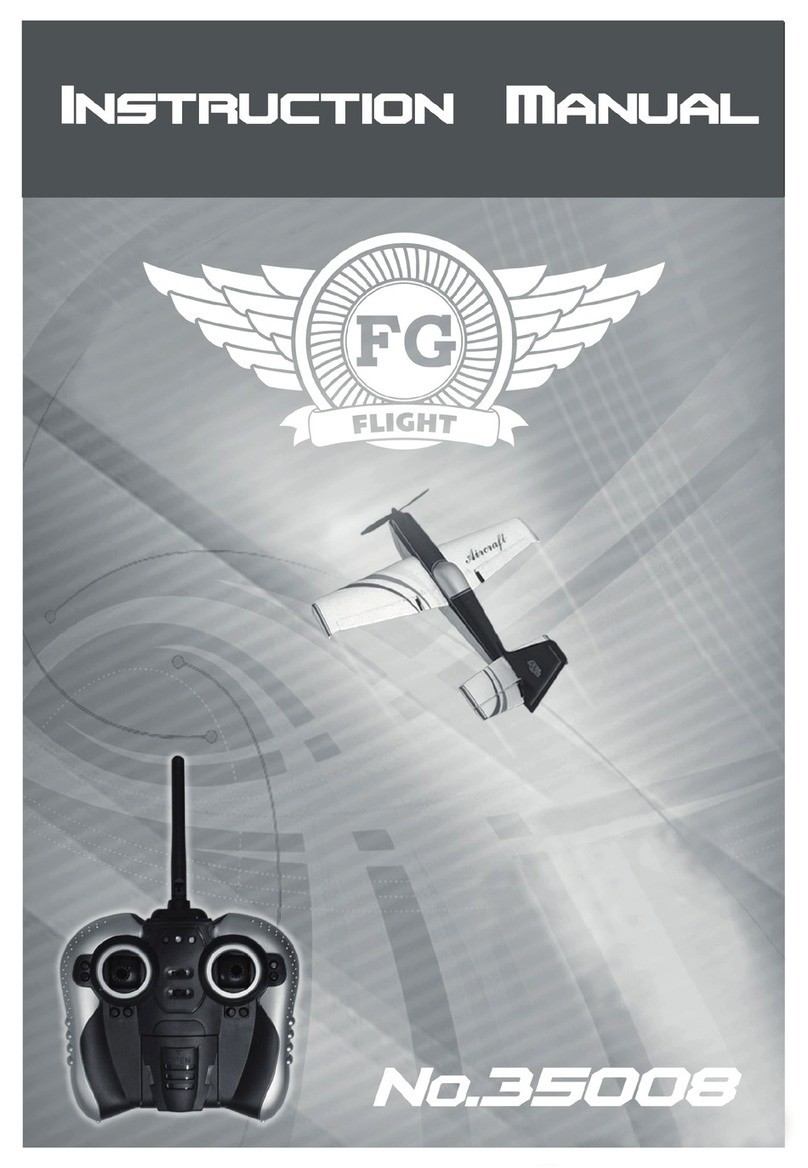
Flying Gadgets
Flying Gadgets 35008 instruction manual
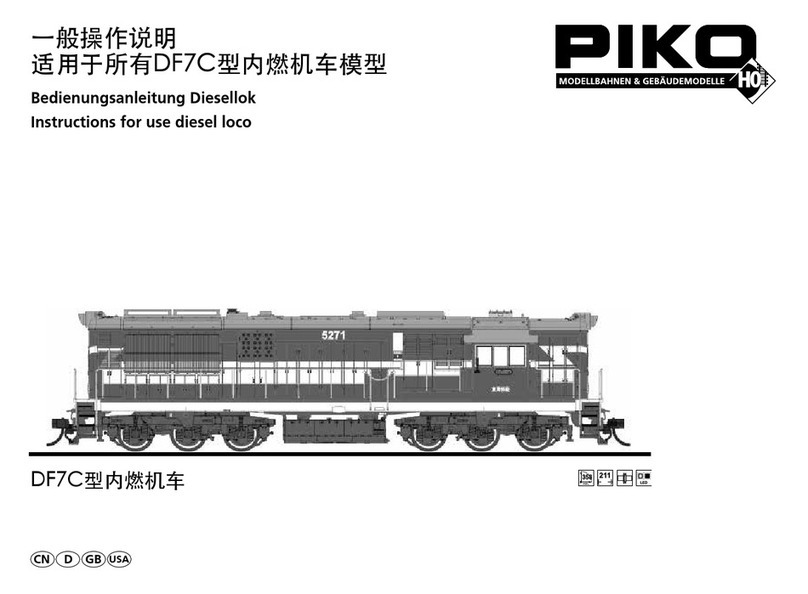
PIKO
PIKO 56301 Instructions for use
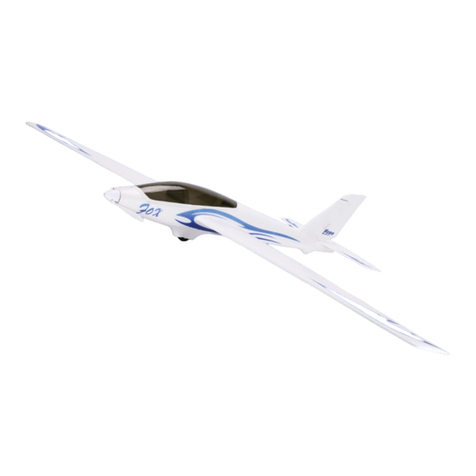
HYPE
HYPE FOX instruction manual
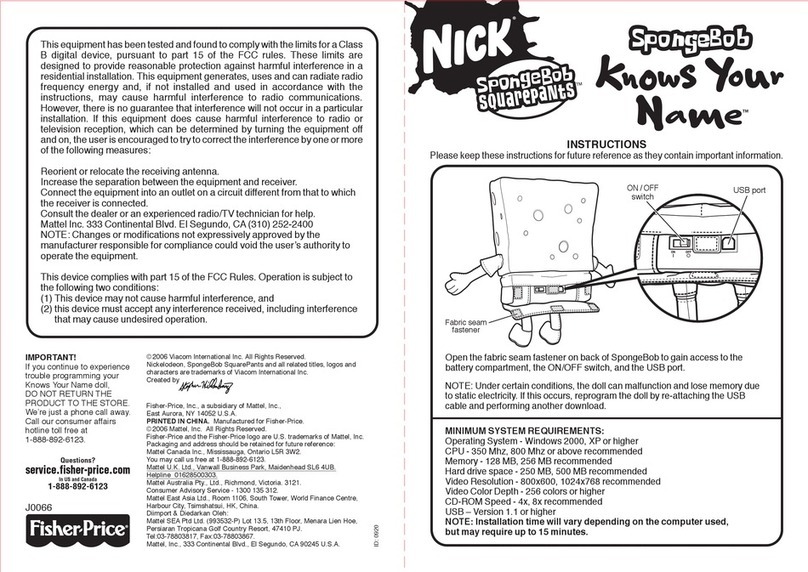
Fisher-Price
Fisher-Price SpongeBob Knows Your Name instructions


